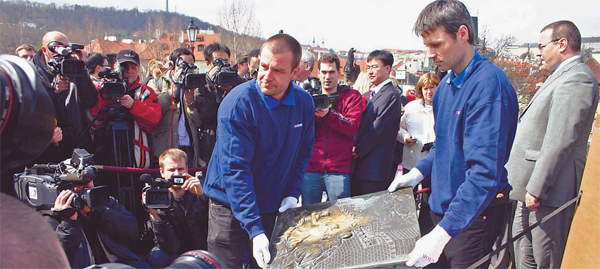|

|
|
Workers remove the bronze plaques from the St John of Nepomuk statue on the Charles Bridge in Prague. The plagues are now installed at the entrance to the Czech Pavilion inside the Expo Garden. MA ZHENHUAN / CHINA DAILY
|
Plaques from the statue of St. John of Nepomuk on Prague's famous Charles Bridge will bring luck to visitors to the Czech Pavilion
Sometimes miracles do happen. The hundreds of Czech and Chinese people gathered on the famous medieval Charles Bridge in Prague in mid-April witnessed such an occasion, when the rain suddenly stopped at noon and the gray sky turned clear - exactly 30 minutes before a ceremony to mark the removal of two plaques from the bridge's St. John of Nepomuk statue.
This was the first time the bronze plaques have been removed from the statue on the bridge. They have since traveled thousands of kilometers to Shanghai for Expo 2010. They have been installed on a replica statue of St. John at the entrance to the Czech Pavilion, where visitors will be able to touch and rub them as they enter - a tradition that is said to bring good fortune.
Of course, there is a folk legend behind all this. In the last half of the 14th century, John of Nepomuk, a priest serving during the reign of King Vclav IV, heard the confessions of many of the townspeople, including Vclav's wife, Queen Sofia.
Vclav was a peace-loving king, but also a very jealous man, and he suspected Sofia of straying from her marriage vows. The king summoned John and asked what the queen had revealed during confession. The priest refused to tell, saying it was confidential. The angry Vclav had John hauled into a dungeon and tortured.
John tried to strike a bargain: if the torture came to an end, he would tell one soul present in the dungeon what the queen had said. The king agreed, assuming John intended to tell him. But John asked that everyone leave the room so he could whisper the secret to the king's dog. The enraged king ordered the torture to continue. Finally, the priest died from his wounds and that night was thrown from Charles Bridge into the river.
Soon after John's murder, there was a great drought and the Vltava River nearly dried up. About 500 meters downstream from the place the priest was tortured, five sparkling points of light appeared over the water. People began digging there and unearthed the body of the priest. The bronze plaques on the statue, warm with human touch and polished to a golden shine, have now become a "magic place" for millions of tourists who believe that to touch them will bring good fortune.
"It all happened one day, when I was walking on Charles Bridge, I noticed dozens of tourists queuing to touch the plaques," Pavel Antonin Stehlik, commissioner general of the Czech Republic to Expo 2010 Shanghai, told China Daily.
"Then the idea struck me. This would be the best symbol for the Czech Republic and it will surely catch visitors' attention at Shanghai Expo," he said.
"Bringing the plaques to Shanghai definitely shows that the Czech government is paying a lot of attention to Shanghai Expo, as the statue is hailed by tourists worldwide as a symbol of Prague," said Cai Ge, charge d'affaires ad interim of the Chinese Embassy to the Czech Republic.
"I think that through the move, the Czech Republic wants to use the Expo as a platform to showcase the Czech's abundant history and culture," he said.
Organizers for the Czech pavilion are also working on a series of exhibitions, which will premiere in Shanghai, in the fields of arts and culture.
Part of the Czech Pavilion will be given over to another exhibition space, the so-called Multimedia Hall, where an exhibition or presentation will be held each month.
For example, May and October will be devoted to Czech arts, which, in part, will be represented in the Monkey King exhibition. Visitors will be able to see the remarkable illustrations of the Chinese legend of the Monkey King by Czech painter Zdenek Sklenar.
China Daily
(China Daily 05/01/2010 page37)

